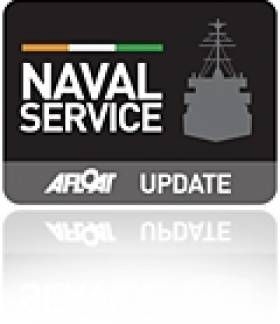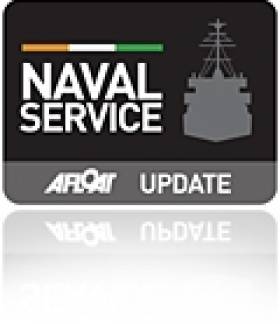Displaying items by tag: OPV Conference
Naval Service Showcase L.E. Samuel Beckett at OPV Conference
#OPVconference- L.E. Samuel Beckett (P61) is appropriately docked in Dublin Port, having arrived last night on the eve of today's start of the International Offshore Patrol Vessels Conference (30 Sept-2 Oct) held in the capital, writes Jehan Ashmore.
The €54m OPV90 class newbuild of 2,226 tonnes is berthed alongside Sir John Rogersons Quay, where a ceremony as previously reported saw her christened and commissioned into the Naval Service in May.
As the class name suggests, the OPV is 90 metres in length, which is 10 metres longer than her predecessor, L.E. Niamh (P52) the second of a pair of 'Roisin' class built for the Naval Service 12 years ago in Appledore, north Devon by Appledore Shipbuilders. The yard is now owned by Babcock Marine & Technology, one of several such facilities in the UK which forms part of Babcock International.
L.E. Samuel Beckett has a crew of 44 though this can be extended to accommodate ten more for cadet trainees. As for her main weapon, this is a OTO Melera 76mm compact gun mounted on the bow, two 20mm Rheinmetall cannon guns located on either side of the funnel casing and elsewhere four smaller machine guns. Engine power is from a pair of 6 cylinder Wartsila diesel motors driving twin shafts that propel a top speed of 23 knots.
Her presence along the Liffey's city centre quays represents the latest in OPV design. From next year she is to feature (UAV) Unmanned Aerial Vehicles for surveillenace purposes as required for the role of the naval branch of the Irish Defence Forces which is in association partnering the major three-day OPV conference.
Among the speakers from the more than 20 nations representing OPV industry stakeholders, navies and shipyards is Andrew Hamilton, head of Babcock International. The same north Devon yard that built L.E. Samuel Beckett, is where her sister L.E. James Joyce is currently under construction as part of an original order for the pair. She is due for completion in the first quarter of 2015.
Last June, the Department of Defence took up the option of ordering a third OPV90 or 'Beckett' class sister from the yard for the fixed price of €54m based on 2012 prices. The yet to be revealed name given for the final member of the class is due for delivery in 2016.
Major Offshore Patrol Vessels Conference Heads for Dublin
#OPVconference- A major three day conference on the Offshore Patrol Vessels industry will be held in Dublin starting tomorrow.
Among the delegates speakers of the International Offshore Patrol Vessels Conference (30 Sept-2 Oct) now in its 9th year will be Rear Admiral Mark Mellett of the Irish Defence Forces who also are hosting the event as associate partners.
The conference which takes place in the Radisson Blu Royal Hotel, will enable opportunities for face-to-face meetings to discuss cost-effective solutions for offshore asset protection and enhanced maritime security with military, OPV shipbuilders and industry stakeholders from the Middle East, Latin America, Africa, Asia, Europe and North America.
The new Samuel Beckett-class OPV as previously featured on Afloat.ie is also discussed by Mellett in Defence IQ (click here for podcast, available through registration).
The Rear Admiral also discusses the construction of the vessel with an eye towards climate change, cost-efficiency in a complex maritime environment, meeting emerging threats, and reveals his key to working effectively with industry partners and shipyards.
On a related note, Babcock Marine & Technology the shipyard which built L.E. Samuel Beckett (and a pair of sisters on order), will be represented at the conference by speaker delegate Andrew Hamilton of Babcock International.
Also attending the conference will be Flag Officer Commanding Commodore Hugh Tully of the Naval Service.
For more details on the conference: www.offshorepatrolvessels.com/Default.aspx































































